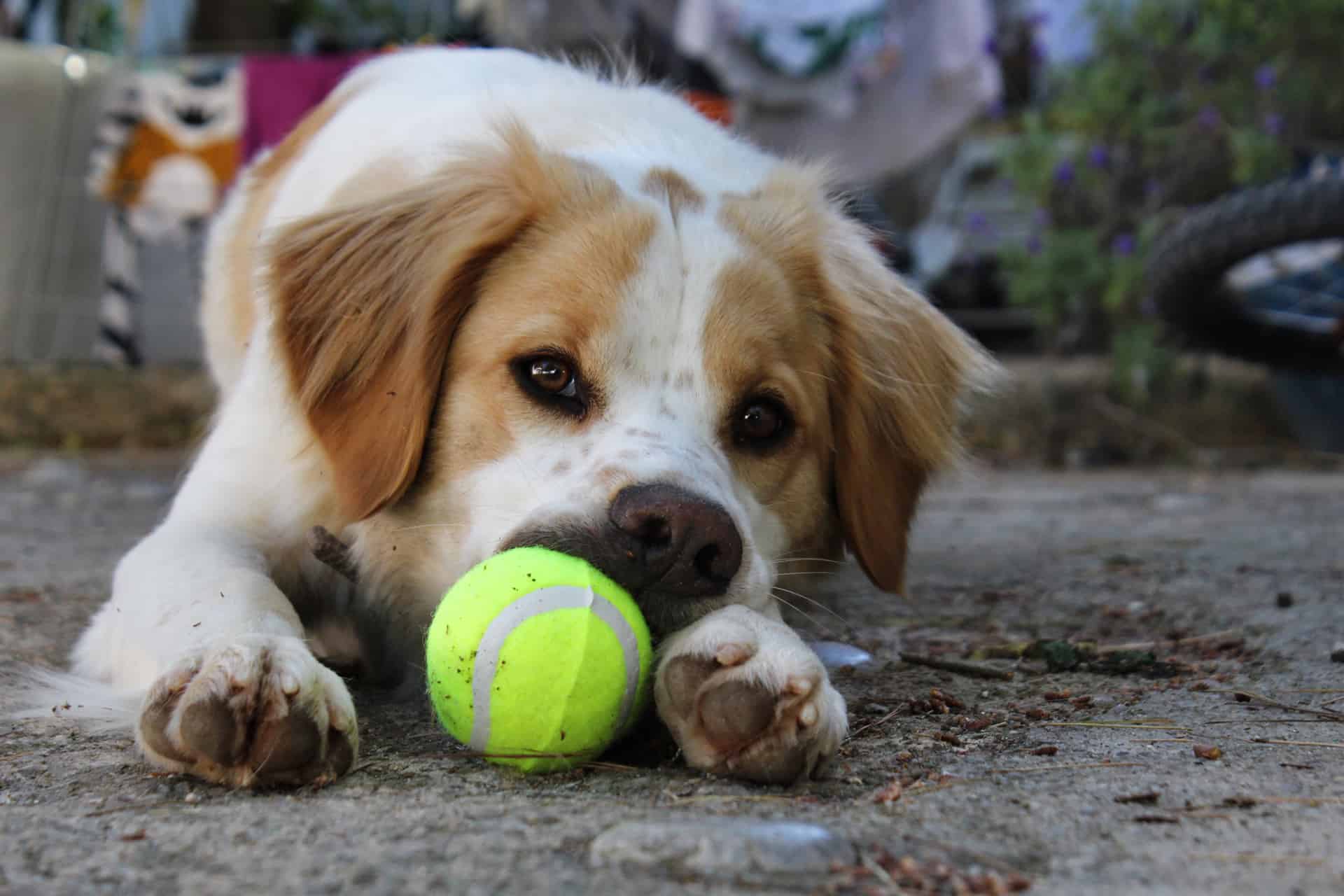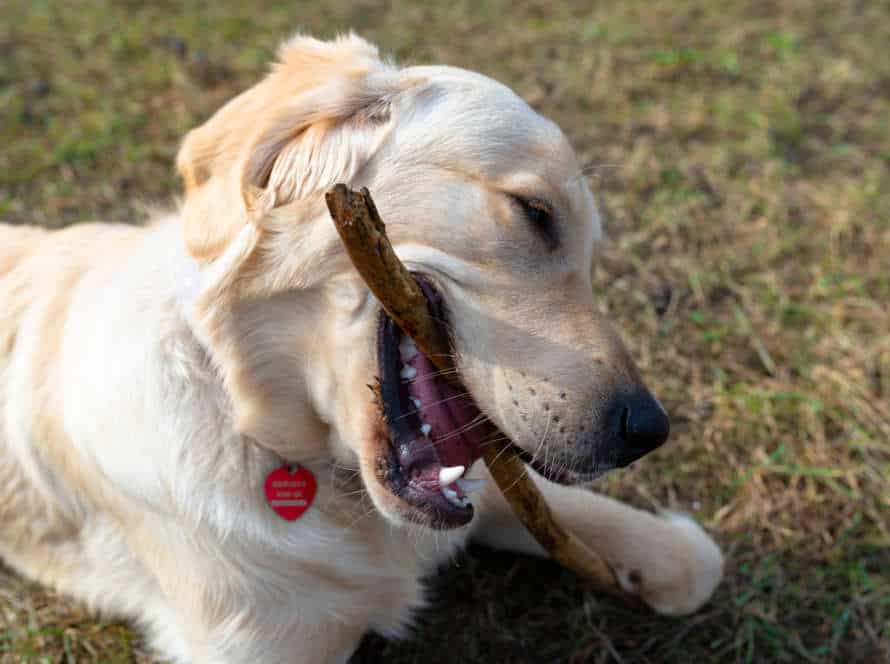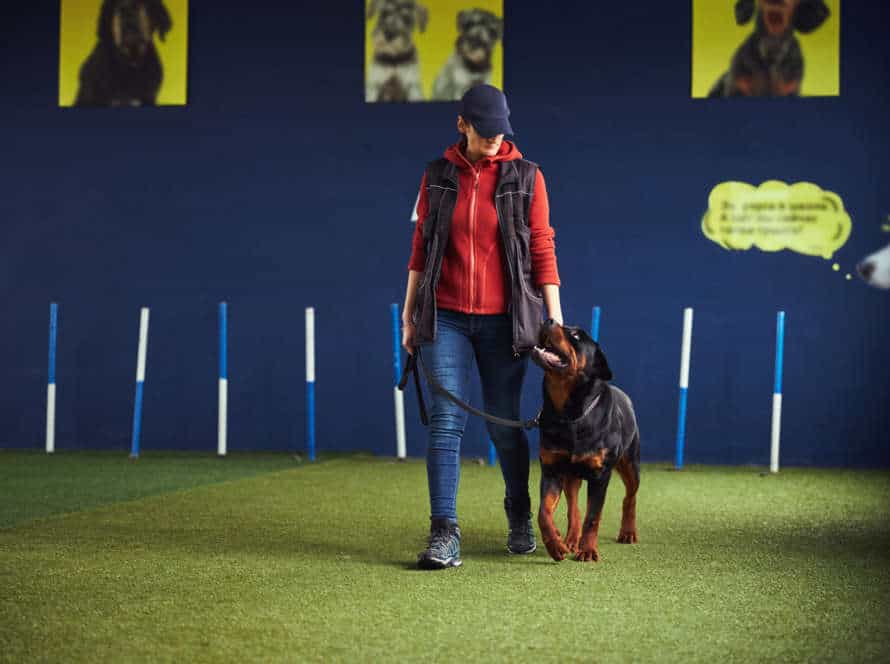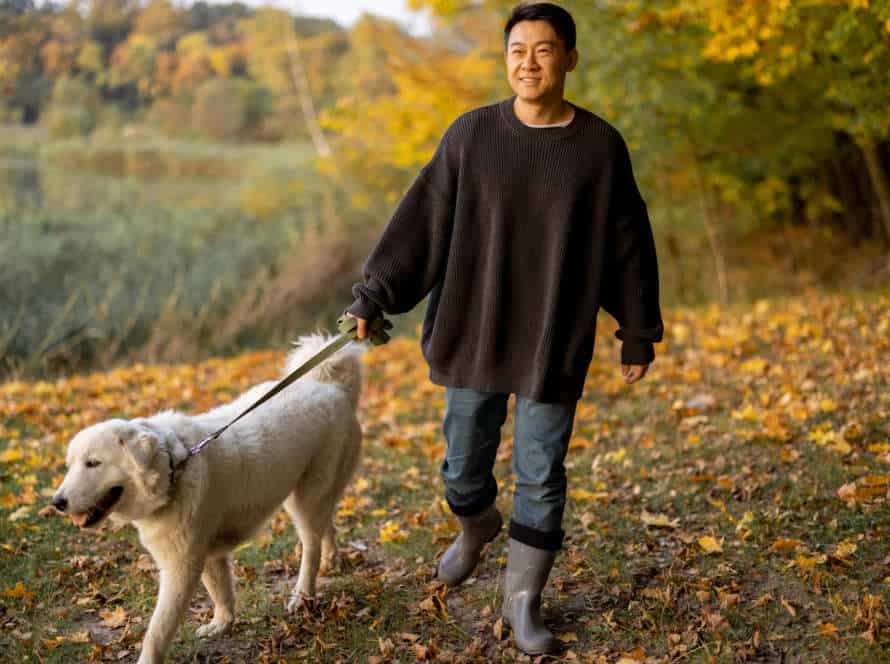Teaching Bite Inhibition in Multi-Dog Households
Teaching bite inhibition in multi-dog households is essential. To make a peaceful, secure home for both canines and humans, here’s what to do:
-
Socialize your puppies from an early age. They’ll learn how to communicate and interact with one another and people.
-
Always monitor them during playtime and interactions. If things become too rough or aggressive, intervene.
-
Use positivity to reward good behavior and discourage bad. Reward calm, gentle play with treats, praise, and attention. Redirect or ignore biting or aggressive behavior.
-
Have different feeding areas for each pup to avoid conflict or resource guarding.
-
If you need help managing their behavior, ask a professional dog trainer or behaviorist for advice.
These steps can help teach bite inhibition, and stop any potential issues in multi-dog households.
Understanding bite inhibition in dogs
Bite inhibition is essential for dogs. It helps them manage the strength of their bites. This is especially true in multi-dog households; it keeps all canines safe from getting hurt. You can teach your pups how to control the strength of their bites. Let’s take a closer look at bite inhibition in multi-dog homes!
Significance of bite inhibition training
Bite inhibition training is vital for all doggos, especially for those living in households with multiple pups. It teaches them to control the power of their bite and lessen the harm caused by play-biting or accidental biting.
It starts when puppies are 3-4 weeks old. Here’s how:
- When they bite too hard, yelp or say “ouch” to startle them.
- Stop interacting/playing with them for a few seconds.
- Resume play after a few moments.
- If they bite hard again, repeat the steps.
Regular practice helps dogs to develop control over their bite, and avoid aggressive or accidental biting in the future.
Pro tip: Consistency is key. You must be patient and consistent when teaching them how to control the power of their bite.
Age-appropriate targets for bite inhibition training
Bite inhibition is essential for all dogs, especially those residing in multi-dog households. Depending on the pup’s age, different goals should be in mind while training.
Pups under 5 months old: Teach them to control the pressure of their bites. They should use a soft mouth, which means using their jaws gently and causing no damage.
Pups aged 5-12 months: Ensure they stop biting when commanded. Let them understand that when you say “no” or “stop,” they should release their bite straight away.
Dogs older than 12 months: Adult dogs should have already learnt bite inhibition. However, extra training can still be done to strengthen their skills or to eliminate any bad habits.
Remember, consistency and positive reinforcement are key for successful bite inhibition training.
Techniques for teaching bite inhibition in multi-dog households
Bite inhibition is a must-have ability for canines to learn. It helps them control their biting force and act properly in various social scenarios. Teaching this skill in multi-dog homes can be a struggle for pet owners. Here are some pointers to help:
- Reward dogs when they show proper bite inhibition behaviour like gentle mouthing or not biting at all.
- Change the biting dog’s focus to chew toys or a game that needs biting specific things.
- Have adult dogs teach and share their biting experiences with puppies. This will help them form good bite inhibition from young.
- If one pup bites the other during play, separate them for a short while. This lowers their excitement and let you re-engage them with positive reinforcement teaching techniques.
With patience and regularity, all doggos can have good bite inhibition skills, no matter their home conditions.
Factors to consider when training for bite inhibition
In multi-dog households, training for bite inhibition is essential. It decreases the potential of aggressive behavior and injuries. Knowing how to recognize signs of aggression, use rewards and punishments, and create rules and structure are factors to consider when teaching bite inhibition. All these steps help to keep multi-dog households safe.
Dog breed and personality
No rule is definite when it comes to a dog’s breed and personality. Certain breeds are renowned for certain traits. This can help you decide which breed fits you and your home. For example, the Golden Retriever is renowned for its outgoing and friendly character, making it ideal for families. The Pit Bull, however, has a reputation for being aggressive. But with correct training and socialization, they can be loving and kind.
When it comes to bite inhibition, it’s important to consider breed, age, gender and if there are multiple dogs in the house. Early socialization and positive reinforcement techniques can help teach bite inhibition and avoid injuries.
History of aggression
Aggressive behavior from dogs can be worrying for pet owners. So, training your dog to avoid such behavior and to have bite inhibition is important.
Age and breed of the dog matter too. Puppies and breeds like Pitbulls and Rottweilers may need special training. It’s essential to know the temperament and traits of your pet.
Bite inhibition teaches control over a dog’s jaw and helps reduce the intensity of a bite. This can be done with socialization, frequent positive reinforcement and desensitizing them to various stimuli.
When it’s a multi-dog household, each pup’s needs should be looked at separately. This prevents any aggressive behavior flare-ups.
By considering these factors, pet owners can make a safe and healthy environment for their furry friends and avoid any issues caused by aggression.
Owner’s availability and time commitment
Training for bite inhibition in a multi-dog home needs lots of time and attention. Consider these factors:
- Each pup’s age and temperament
- Prior training and socialization
- Past and present biting habits
- Household dynamics and daily routines
- Owner’s availability and commitment
For successful teaching, owners must give each dog dedicated time while using positive reinforcement techniques. Biting should be discouraged and gentle play encouraged. Intervene if needed to stop bites or aggressive behavior. Tip: Patience and consistency are essential!
Steps for effective bite inhibition training
Multi-dog households must carry out bite inhibition training for a safe and joyous environment. This teaching will help pooches learn to be tender when playing together. It also diminishes the possibility of aggression and injury between the dogs. Herein, we will be discussing the steps for successful bite inhibition training.
Safety measures for both dogs and people involved in training
Bite inhibition training for dogs requires safety measures. Here are some to keep in mind:
- Use a muzzle if the dog is aggressive or reactive.
- Separate dogs when teaching.
- Supervise children away from the training area.
- Use positive reinforcement, such as treats and praise.
- Be patient – training takes time.
For safe and effective training, follow these guidelines!
Desensitization and counter-conditioning techniques
Teaching bite inhibition in multi-dog households? Desensitization & counter-conditioning techniques are essential!
Firstly, identify triggers which cause aggressive behavior.
Then, desensitize the dogs by exposing them to these triggers at low levels, increasing intensity over time.
Counter-conditioning can help too – pair the trigger with positive reinforcement (treats, toys, praise).
Be consistent – reward good behavior or progress.
If aggression is high between dogs, separate them for sessions.
Pro Tip: Bite inhibition is best taught when puppies, start early!
Practicing supervised interaction with other dogs
Supervised interaction with other dogs is an amazing way to teach bite inhibition training to your pup, especially in multi-dog households. Here are a few steps to help you out:
- Begin by introducing your dog to other canines one at a time in a regulated environment like a dog park or a friend’s backyard.
- While supervising their interaction, keep an eye on their body language and intervene if needed to stop any aggressive actions.
- Offer them positive reinforcement like treats or toys when they show good behavior.
- Gradually add more dogs and the length of their contact.
- Educate your dog the “leave it” command to discourage bad behavior.
- Monitor your pup’s progress and make changes as necessary to guarantee their bite inhibition training is effective.
Consistent and patient training will help your dog learn the right conduct around other dogs and become socially skilled.
Consistency in training and reinforcement
Training multiple pooches in one home can be tough. Especially when teaching each pup bite inhibition. Consistency and reinforcement are vital for teaching bite inhibition. All dogs must get the same message. Bite inhibition can be learned in a multi-dog house with repetition and consistency.
Importance of consistent reinforcement for developing bite inhibition
Consistent reinforcement is a must when teaching bite inhibition to pups, especially in multi-dog homes. Bite inhibition is when a dog can control the strength of their bites. Puppies learn this skill through play-biting with their siblings and mom.
But if they’re left alone or with multiple dogs, they may keep biting hard during play, which can be risky as they grow.
Here’s how consistent reinforcement can help:
- Set clear rules about playtime and biting in your home.
- Reward gentle play with treats and praise, and discourage hard bites.
- Be consistent in enforcing all rules and rewarding good behavior.
- Immediately correct biting behavior by taking away attention or using a firm “No“.
With consistent reinforcement and proper training, all dogs in a multi-dog household can learn proper play behavior, including bite inhibition.
Staying patient during the training process
Patience is a must when teaching bite inhibition in multi-dog households. Consistency and reinforcement are key to success. Here are some useful tips to help you stay patient:
- Set achievable goals and be patient. Bite inhibition training can take weeks or even months.
- Use positive reinforcement like treats and praise.
- Make sure everyone uses the same technique to avoid confusion and setbacks.
- Take regular breaks and try different methods if needed. Every dog is unique – it may take some trial and error.
Patience is vital for success. Pro tip: Practicing bite inhibition can prevent future biting incidents.
Regular review of progress and modification of training approach if needed
Training bite inhibition in a multi-dog household? Consistency is key! Keep an eye on your progress and change up your approach if needed. Here’s some tips to remember:
- Log every session with each dog. Notice any challenges or setbacks.
- Check your logs regularly and assess your progress. Identify patterns and evaluate your training.
- Modify your approach when needed. Change timing, pacing or techniques.
- Reinforce the progress through positive reinforcement – like praise or treats.
Pro-tip: Get all household members involved for maximum consistency.
Seeking professional help
Multiple dogs in your home? Difficult to teach them bite inhibition? Seek help from a pro! They can create an effective training plan and guide you on managing multiple dogs. Furthermore, they can help you recognise and respond to aggression and fear signals, plus teach effective bite inhibition.
When to seek the assistance of a professional dog trainer
Training bite inhibition in a multi-dog house can be tough. Therefore, it’s best to seek professional help in such situations.
Examples:
- If a bite is strong enough to break skin, or if the dog shows aggression to others.
- When pups are in a key developmental period.
- When there’s rivalry between dogs or territorial problems.
A pro trainer can assess behavior and make a suitable plan, based on individual needs. They will provide you tools and knowledge to help your dogs learn better habits, and manage any issues that come up during training.
Pro Tip: Check credentials of dog trainers before hiring, to ensure they are qualified to help you and your pooches.
Benefits of enrolling dogs in professional training classes
Enrolling your pup in pro training classes can offer heaps of advantages. Especially when teaching bite inhibition in households with multiple doggos. Here are some perks of pro dog training classes:
- Socialization: Dogs that socialize well are more self-assured, calmer and get along better with other dogs & humans.
- Better communication: Training classes help you and your pup understand each other better.
- Stopping bad habits: Trainers can help you teach your pup basic commands and nix behaviors like biting, loud barking and jumping up.
- Teaching bite inhibition: Professional trainers can help your pup learn bite inhibition, particularly important in multi-dog homes where play gets rough.
Pro tip: Don’t forget to practice and reinforce what your pup learns at home!
Choosing the right trainer for bite inhibition training in multi-dog households
Teaching bite inhibition to multiple dogs can be hard. Seeking professional help is a smart move. Here are some tips for selecting the right dog trainer:
- Look for a trainer with experience handling multi-dog households and who specializes in behavior modification.
- Check the trainer’s credentials and certifications. A CPDT is a great option.
- Read reviews and ask for references from prior clients.
- Pick a trainer who uses positive reinforcement and no physical punishments or harsh methods.
- Make sure the trainer has liability insurance in case of accidents.
- Schedule a consult with the trainer to evaluate their knowledge, techniques, and compatibility with your dogs.
Pro tip: Give each dog individual attention when training multiple dogs to prevent competition or aggression.
Frequently Asked Questions
1. How do I teach bite inhibition to my dogs?
A: You can teach bite inhibition to dogs by encouraging them to play gently and rewarding them when they do so. You should also discourage rough play and avoid using physical punishment.
2. Should I train all of my dogs together or separately?
A: It is recommended to start with training each dog separately and gradually introduce them to each other while supervising their interactions.
3. How can I prevent my dogs from fighting over resources?
A: Provide plenty of resources for all dogs, including food bowls and toys, and supervise meal times to ensure each dog gets their fair share. Also, teach them commands such as “leave it” and “drop it” to prevent resource guarding.
4. What should I do if my dogs get into a fight?
A: Immediately separate the dogs and seek veterinary care for any injuries. Once the dogs have calmed down, work on training exercises to prevent future fights and seek professional help if necessary.
5. Will teaching bite inhibition prevent my dogs from ever biting?
A: While teaching bite inhibition can reduce the likelihood of your dogs biting, it cannot guarantee that they will never bite in certain situations such as when they feel threatened or in pain.
6. How long does it typically take to teach bite inhibition to dogs?
A: The length of time it takes to teach bite inhibition can vary depending on the individual dog and their behavior, but with consistent training, it can typically take several weeks to several months to see progress.







